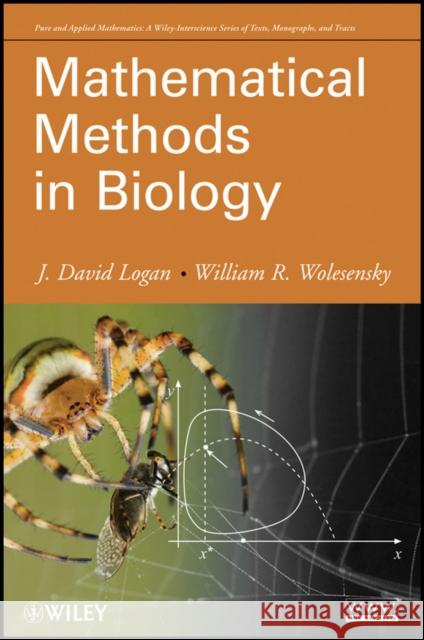Mathematical Methods in Biology » książka



Mathematical Methods in Biology
ISBN-13: 9780470525876 / Angielski / Miękka / 2009 / 436 str.
Mathematical Methods in Biology
ISBN-13: 9780470525876 / Angielski / Miękka / 2009 / 436 str.
(netto: 427,44 VAT: 5%)
Najniższa cena z 30 dni: 446,96
ok. 30 dni roboczych
Bez gwarancji dostawy przed świętami
Darmowa dostawa!
Mathematical Methods in Biology uniquely covers both deterministic and probabilistic models, including algorithms in the MATLAB platform. The book focuses mostly in one area of the life sciences, focusing mainly on theoretical ecology.
"Admirably, the volume is written with bits of MATLAB code inserted at appropriate places and has exercises interspersed throughout the text (as well as hints for solutions to the exercises at the end of the book)." The Quarterly Review of Biology, June 2010)
"The mathematical and reasoning sophistication increases as the chapters proceed." (Book News, December 2009)
Preface.
1. Introduction To Ecological Modeling.
1.1 Mathematical Models.
1.2 Rates of Change.
1.3 Balance Laws.
1.4 Temperature in the Environment.
1.5 Dimensionless Variables.
1.6 Descriptive Statistics.
1.7 Regression and Curve Fitting.
1.8 Reference Notes.
2. Population Dynamics for Single Species.
2.1 Laws of Population Dynamics.
2.2 Continuous Time Models.
2.3 Qualitative Analysis of Population Models.
2.4 Dynamics of Predation.
2.5 Discrete Time Models.
2.6 Equilibria, Stability, and Chaos.
2.7 Reference Notes.
3. Structure and Interacting Populations.
3.1 Structure––Juveniles and Adults.
3.2 Structured Linear Models.
3.3 Nonlinear Interactions.
3.4 Appendix––Matrices.
3.5 Reference Notes.
4. Interactions in Continuous Time.
4.1 Interacting Populations.
4.2 Phase Plane Analysis.
4.3 Linear Systems.
4.4 Nonlinear Systems.
4.5 Bifurcation.
4.6 Reference Notes.
5. Concepts of Probability.
5.1 Introductory Examples and Definitions.
5.2 The Hardy–Weinberg Law.
5.3 Continuous Random Variables.
5.4 Discrete Random Variables.
5.5 Joint Probability Distributions.
5.6 Covariance and Correlation.
5.7 Reference Notes.
6. Statistical Inference.
6.1 Introduction.
6.2 Interval Analysis.
6.3 Estimating Proportions.
6.4 The Chi–Squared Test.
6.5 Hypothesis Testing.
6.6 Bootstrap Methods.
6.7 Reference Notes.
7. Stochastic Processes.
7.1 Introduction.
7.2 Randomizing Discrete Dynamics.
7.3 Random Walk.
7.4 Birth Processes.
7.5 Stochastic Differential Equations.
7.6 SDEs from Markov Models.
7.7 Solving SDEs.
7.8 The Fokker–Planck Equation.
7.9 Reference Notes.
A. Hints and Solutions to Exercises
J. David Logan, PhD, is Willa Cather Professor of Mathematics at the University of Nebraska Lincoln. He has written more than eighty research articles in his areas of research interest, which include mathematical physics, combustion and detonation, hydrogeology, and mathematical biology. Dr. Logan is the author of Applied Mathematics, Third Edition and An Introduction to Nonlinear Partial Differential Equations, Second Edition, both published by Wiley. William R. Wolesensky, PhD, is Associate Professor in the Department of Mathematics at Doane College. Dr. Wolesensky has written numerous journal articles on the use of mathematical modeling techniques in scientific research.
A one–of–a–kind guide to using deterministic and probabilistic methods for solving problems in the biological sciences
Highlighting the growing relevance of quantitative techniques in scientific research, Mathematical Methods in Biology provides an accessible presentation of the broad range of important mathematical methods for solving problems in the biological sciences. The book reveals the growing connections between mathematics and biology through clear explanations and specific, interesting problems from areas such as population dynamics, foraging theory, and life history theory.
The authors begin with an introduction and review of mathematical tools that are employed in subsequent chapters, including biological modeling, calculus, differential equations, dimensionless variables, and descriptive statistics. The following chapters examine standard discrete and continuous models using matrix algebra as well as difference and differential equations. Finally, the book outlines probability, statistics, and stochastic methods as well as material on bootstrapping and stochastic differential equations, which is a unique approach that is not offered in other literature on the topic.
In order to demonstrate the application of mathematical methods to the biological sciences, the authors provide focused examples from the field of theoretical ecology, which serve as an accessible context for study while also demonstrating mathematical skills that are applicable to many other areas in the life sciences. The book′s algorithms are illustrated using MATLAB®, but can also be replicated using other software packages, including R, Mathematica®, and Maple; however, the text does not require any single computer algebra package. Each chapter contains numerous exercises and problems that range in difficulty, from the basic to more challenging, to assist readers with building their problem–solving skills. Selected solutions are included at the back of the book, and a related Web site features supplemental material for further study.
Extensively class–tested to ensure an easy–to–follow format, Mathematical Methods in Biology is an excellent book for mathematics and biology courses at the upper–undergraduate and graduate levels. It also serves as a valuable reference for researchers and professionals working in the fields of biology, ecology, and biomathematics.
1997-2025 DolnySlask.com Agencja Internetowa
KrainaKsiazek.PL - Księgarnia Internetowa









